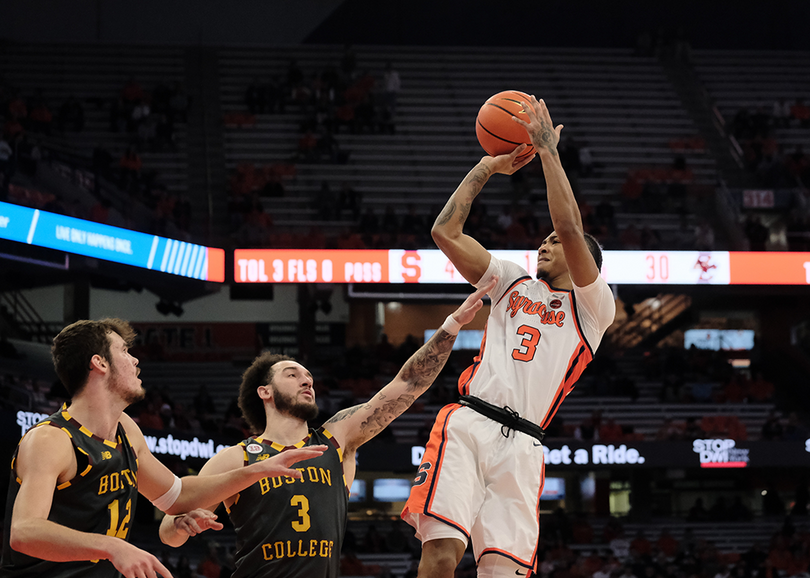Data Dive: SU’s statistical inconsistencies leading into final half of the season

More than halfway into the season, 3-point shooting, forced turnovers and rebounding have been crucial to Syracuse’s game. Maxine Brackbill | Photo Editor
Get the latest Syracuse news delivered right to your inbox. Subscribe to our sports newsletter here.
After Quadir Copeland sank a buzzer-beating 3-pointer to beat Miami 72-69, Syracuse (13-5, 4-3 ACC) picked up its fourth conference win of the season and currently sits in sixth place in the Atlantic Coast Conference. The win secured the Orange’s second-straight victory following the season sweep over Pittsburgh.
Through 18 games, the Orange have had some big wins over Oregon, Miami and LSU. They excel on their home floor, boasting a perfect 9-0 record in the Dome, but they’ve had disappointing outings at North Carolina, Duke and Virginia, all of which were 20-point plus defeats.
Aside from a game against Boston College on Jan. 30, three of Syracuse’s next four opponents sit in the top five in the conference. As the Orange approach the back half of conference play, here are the numbers that have defined Syracuse’s season:
Crashing the boards
Head coach Adrian Autry has constantly emphasized the importance of winning the rebounding battle. Syracuse has a rebounding margin of -1.8, ranking second-worst in the conference ahead of Virginia.
With former starting center Naheem McLeod out for the season, the Orange have turned to Maliq Brown as the go-to option on the boards. Brown leads the team with 6.2 rebounds per game.
In defeats, the Orange have lost the rebounding margin by 12.6 boards per game, including a 53-30 margin versus North Carolina in Syracuse’s worst ACC defeat ever. SU also was outrebounded by 20 against Gonzaga. Versus the Tar Heels, Armando Bacot and Harrison Ingram both corralled double-digit boards, including seven of 19 offensive rebounds.
“That’s what they do,” Autry said of Bacot and Ingram. “We just didn’t do a good job of keeping bodies on them. We just didn’t do a good job at all, defensively.”
The Orange sit ninth in the conference with 10.1 offensive rebounds per game, but they have an offensive rebounding rate of 26.7% which ranks in the bottom third of D-I basketball, per KenPom. Syracuse opponents’ offensive rebounds account for 32.1% of their total rebounds, which is 282nd nationally, per KenPom.

Cindy Zhang | Digital Design Director
Ball hawks
On the defensive end, Syracuse is one of the best at forcing loose balls and blocking shots in the conference. Judah Mintz and Brown are tied for second in the ACC with 39 steals, helping the Orange lead the conference in steals per game (9.17).
Versus Boston College on Jan. 10, Syracuse recorded a season-high 17 takeaways, the most since the team notched 18 in a double-overtime victory over Indiana in 2021. In six games that Syracuse has notched double-digit steals, the Orange have won five of them. In victories, SU averages 9.76 steals per game, but drops to 7.6 in defeats.
“I thought we had probably one of our better defensive games that we had in conference play this year,” Autry said postgame after BC.
Per KenPom, Syracuse opponents turn the ball over on 20.6% of possessions, a mark where Syracuse is 38th best in the nation.
The Orange are also one of the strongest blocking teams in the ACC, averaging 4.8 blocks per game, which is second-best in the ACC. Syracuse notched a season-high nine rejections in a win over Cornell in December.
In wins, the Orange notch 5.1 blocks per game. In losses, they block 3.8 shots per game.
The 3-ball
The 3-pointer has been a double-edged sword for Syracuse. In wins over Pittsburgh and Miami when SU drained 10 and 12 3s, respectively, the 3-pointer was the hero. But in games against Virginia, which made 12 on the Orange, or when Duke went a perfect 9-of-9 in the second half, the 3-ball has been the villain.
Defensively, Syracuse guards the perimeter well, limiting teams to just a 30.6% clip from beyond the arc, which is third-best in the ACC. In conference games, opponents make just under 35% of shots from deep. In SU’s five losses, it made 4.4 3-pointers per game while opponents made just under eight.
In the buzzer-beater win over Miami, which came as a result of a Copeland left-wing 3, the Orange beat Miami at its own game — the Hurricanes entered as one of the top 3-point shooting teams nationally. J.J. Starling recorded a career-high six 3s while Chris Bell also made four crucial triples in the win.
“The ball started moving more,” Starling said postgame. “We found the open man, we made simpler plays, and we just started knocking on shots.”

Cindy Zhang | Digital Design Director
Not too many close games
Win or loss, Syracuse hasn’t been in many games that have come down to the wire. The Orange’s defeats have all been blowout losses, losing by an average of 22.8 points. Syracuse kept it close with Duke and Tennessee in the first half, but it dwindled in the second half. In the others, it was dominated from start to finish.
Just three games — Colgate, Miami and the first matchup with Pitt — have been decided by single digits, all of which Syracuse won. In its 13 wins, Syracuse has won by an average margin of 15.1 points and in conference play, the average margin of victory is cut to eight.
Against Colgate, Syracuse came back from a 24-point deficit and versus Miami, it was the first true back-and-forth game down to the final seconds. Down the stretch against the Hurricanes, Autry said he felt his team was prepared to handle a close game.
“If we get to end-of-game situations and we’re tied or we’re down one, I feel good about what we can do, how we can get a really good shot.”





